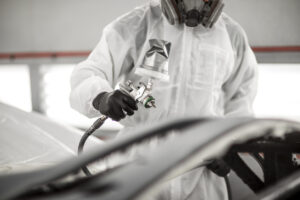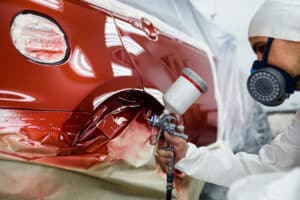Car Paints Compared: Lacquer, Urethane and More
On the surface, it might seem like the only decisions to be made when choosing a car paint are which finish and colour you want to achieve. However, this isn’t necessarily the case.
Whether you’re a professional in a bodyshop, or working on a DIY paint project – you’ll still need to decide which chemical makeup to use on your car. From longer-lasting to easy-application paint types, there are quite a few pros and cons to consider.
In this guide, we’ll be comparing the properties of the various types of car paint available, looking specifically at the chemical makeup of each one to help you decide which is right for you.
What are the different chemical makeups of car paint?
There are several different chemical makeups of car paint to choose from. Below, we’ll run you through what they are, alongside the benefits and drawbacks of each one.
Acrylic Lacquer
Lacquer is technically the oldest type of car paint, alongside being one of the most used since it was the sole option for a long time. However, its popularity is now dwindling because of the availability of other, better paint chemical makeups on the market. In some states in America, like California, lacquer car paint has even been banned because of its high impact on the environment.
Pros:
- Easy to apply due to the acrylic base
- Can achieve a high-gloss finish
Cons:
- Fades relatively quickly with UV exposure
- Banned in some parts of the world
- Can have a high environmental impact
- Can’t be painted over urethane
Urethane
Urethane paint is often the most long-lasting of all the different chemical makeups, although it can also be one of the messiest when applying to your car. This paint type is often recommended for use by professionals only because of its quick-drying properties and long-lasting, high-quality finish when applied correctly. The quick-drying can be difficult for less experienced painters to handle.

Pros:
- Longer lasting than others
- Fade and chip resistant
- Can be painted over most previous paint types
- Quick drying
Cons:
- Can be more expensive than enamel paint
- Can’t paint over with lacquer
- Can be difficult to apply, making it largely unsuitable for DIY users
Acrylic Urethane
Acrylic urethane is a newer version of standard urethane paint designed with the addition of acrylic to help with the application. A catalyst has also been added to this two-part paint to help speed up its drying process.
Pros:
- Easier to apply than normal urethane paint
- Long-lasting, like enamel
Cons:
- Can still be difficult to apply, meaning DIYers could struggle
- Requires quick and skilled application before it dries
Acrylic Enamel
There are two types of enamel paint available, which are:
- Single-Stage: Single-stage enamel paints only require a single layer of paint since the base coat and clear coat have been mixed.
- Two-Stage: The base coat and clear coat are applied in separate stages for two-stage enamel paints.
Both enamel paint types cover the surface of the car with a strong, hard shell. This type of chemical makeup provides a long-lasting, durable finish at a lower cost than the other options, although the process can be more complex when applying.
Pros:
- Long-lasting
- Durable
- Cheaper than other options
Cons:
- Can be difficult to apply, like urethane
- Paint needs to be baked with specific equipment, which means it’s more suitable for professionals in the bodyshop and less so for DIY users
- The overall process can take longer with two-stage paint

How to decide which car paint is right for you
Once you understand the differences between the chemical makeup of the paints available, it can be handy to consider the following before making a final decision:
Budget
Your budget can play a big role in which paint type you choose. For example, urethane paints can be one of the most expensive options, while enamel paints are much cheaper. You should factor these prices into your decision to ensure you don’t accidentally blow your budget. If you’re working with a body shop professional, they should help steer you in the right direction.
The cost-effectiveness can also be important since a longer-lasting paint like enamel or urethane will require less rework over time. While these might be more costly initially, the cost of repainting can quickly add up with the cheaper paint types.
Who is painting?
Some paint types are easier to work with than others, so bodyshop professionals with more experience and knowledge of how to handle the different chemical makeups will have more choices. For those starting out in the industry, however, it might be easier to opt for easier-to-use paints, such as lacquer. Those DIYing should also consider that some paint types aren’t recommended for use by non-professionals, so this should be a big factor in which type you go for.
Consider the application method and drying process during this stage.
Legality
You should always check that the paint type you want to use is legal in your country or state – especially if you’re painting it yourself. Lacquer can be banned in some areas because of its environmental impact, so always read up on the laws that are in place to make sure you’re not breaking any.
Whatever the job at hand, we hope our guide has provided some useful insight to help you come to a decision on which car paint makeup to go for. Whether you’re a seasoned professional or just finding your feet in the industry – it’s never too late or too early to boost your body shop knowledge. The more you know about the products you’re working with, the more confident you can be in your ability to complete jobs to a higher standard.
Our tape solutions have been meticulously designed for use with car paints of all kinds. Visit our online store to discover the full range of JTAPE products available, or contact us to find your local distributor.


